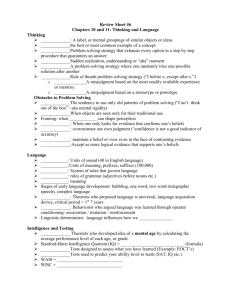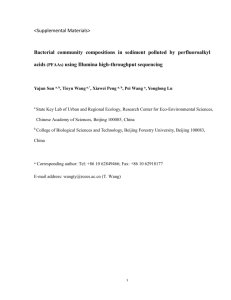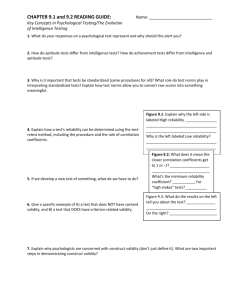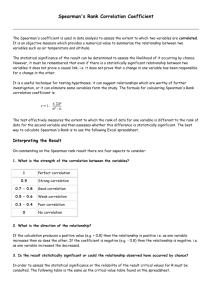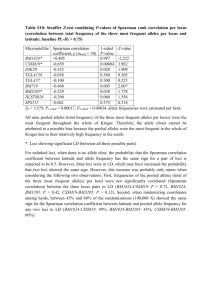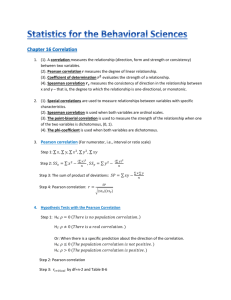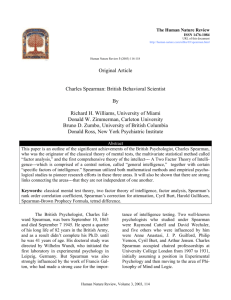Charles Spearman - The Personality Project
advertisement
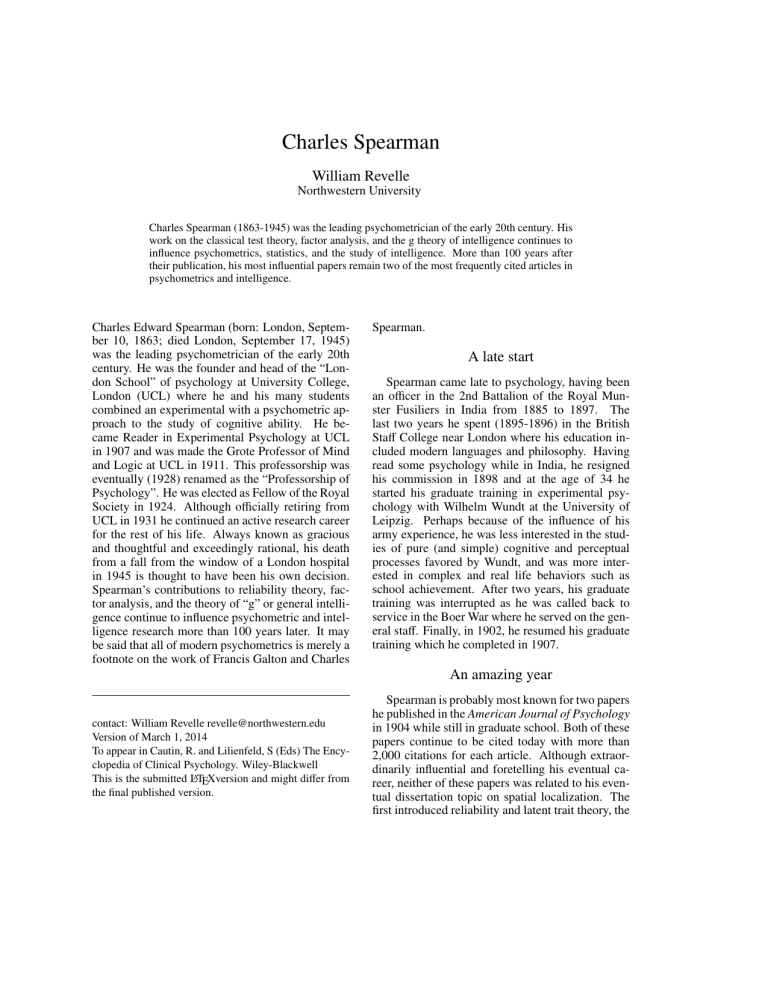
Charles Spearman William Revelle Northwestern University Charles Spearman (1863-1945) was the leading psychometrician of the early 20th century. His work on the classical test theory, factor analysis, and the g theory of intelligence continues to influence psychometrics, statistics, and the study of intelligence. More than 100 years after their publication, his most influential papers remain two of the most frequently cited articles in psychometrics and intelligence. Charles Edward Spearman (born: London, September 10, 1863; died London, September 17, 1945) was the leading psychometrician of the early 20th century. He was the founder and head of the “London School” of psychology at University College, London (UCL) where he and his many students combined an experimental with a psychometric approach to the study of cognitive ability. He became Reader in Experimental Psychology at UCL in 1907 and was made the Grote Professor of Mind and Logic at UCL in 1911. This professorship was eventually (1928) renamed as the “Professorship of Psychology”. He was elected as Fellow of the Royal Society in 1924. Although officially retiring from UCL in 1931 he continued an active research career for the rest of his life. Always known as gracious and thoughtful and exceedingly rational, his death from a fall from the window of a London hospital in 1945 is thought to have been his own decision. Spearman’s contributions to reliability theory, factor analysis, and the theory of “g” or general intelligence continue to influence psychometric and intelligence research more than 100 years later. It may be said that all of modern psychometrics is merely a footnote on the work of Francis Galton and Charles Spearman. A late start Spearman came late to psychology, having been an officer in the 2nd Battalion of the Royal Munster Fusiliers in India from 1885 to 1897. The last two years he spent (1895-1896) in the British Staff College near London where his education included modern languages and philosophy. Having read some psychology while in India, he resigned his commission in 1898 and at the age of 34 he started his graduate training in experimental psychology with Wilhelm Wundt at the University of Leipzig. Perhaps because of the influence of his army experience, he was less interested in the studies of pure (and simple) cognitive and perceptual processes favored by Wundt, and was more interested in complex and real life behaviors such as school achievement. After two years, his graduate training was interrupted as he was called back to service in the Boer War where he served on the general staff. Finally, in 1902, he resumed his graduate training which he completed in 1907. An amazing year contact: William Revelle revelle@northwestern.edu Version of March 1, 2014 To appear in Cautin, R. and Lilienfeld, S (Eds) The Encyclopedia of Clinical Psychology. Wiley-Blackwell This is the submitted LATEXversion and might differ from the final published version. Spearman is probably most known for two papers he published in the American Journal of Psychology in 1904 while still in graduate school. Both of these papers continue to be cited today with more than 2,000 citations for each article. Although extraordinarily influential and foretelling his eventual career, neither of these papers was related to his eventual dissertation topic on spatial localization. The first introduced reliability and latent trait theory, the 2 PMC LAB second introduced factor analysis and evidence supporting a theory of the general factor of intelligence. The proof and measurement of association between two things (AJP, 1904 pp 72-101) expanded on Galton’s idea of the correlation coefficient. Galton’s papers in 1886 and 1888 had introduced his coefficient of “regression towards mediocrity”, or r, and gave some very good examples of the process of correlation. Galton’s original insight was then elaborated by Karl Pearson in 1896 into the correlation that bears his name (the Pearson Product Moment Correlation Coefficient). Spearman recognized that the mathematical treatment found in Bravais or Pearson was probably not helpful to most psychologists and thus laid out in seemingly very simple terms the notion of correlation, reliability, and correction for unreliability. Seen from the advantage of a century later, this paper is a masterpiece in that it also considers the advantages of a rank order correlation (Pearson r applied to ranked data rather than the raw data) which is more robust to outliers than is the normal Pearson correlation, discusses problems in restriction of range, and gives statistical tests for the probability of any correlation. The paper also introduces the concept of part and partial correlation as a way of controlling for extraneous variables. Although many of these ideas had been discussed earlier by Pearson, Spearman’s clear exposition of the ideas and demonstrations of their applications to the study of cognitive performance were very influential for students of individual differences. His decomposition of an observed score into a true score and an error score and the introduction of parallel tests to measure reliability are the fundamental statements of what is known as classical test theory. The next issue of the American Journal of Psychology included Spearman’s second masterpiece: “general intelligence,” objectively determined and measured (AJP, 1904, 201-292) which was a tour de force critiquing prior experimental work combined with the demonstration of the power of the correlation coefficient when corrected for attenuation. Reviewing earlier studies which failed to find correlations between experimental measures and ratings of intelligence, Spearman discussed problems in restriction of range, poorly practiced or unmotivated subjects, and generally poor measurement. Spearman dismissed some prior studies because of these errors, and then reported on his own five stud- ies (albeit with very small samples of local school children, local adults, and students at a prestigious “public” school). He found that the low intercorrelations of simple cognitive measures with high level performance measures reflected more the quality of measurement than it did the underlying relationships. Correcting for unreliability, and in particular, correcting for the unreliability within each domain (simple cognitive tasks and academic achievement by finding average domain correlations), Spearman developed the basic principles of factor analysis. This was particularly amazing in that it was done without the influence of linear or matrix algebra nor the high speed computing that has made factor analysis and structural equation modeling such a standard for quantitative research. Influence on the field Based partly upon these two early papers, Spearman was offered a position at UCL to head the new experimental psychology program there. Over the next 30 years the “London school” of individual differences was the home of such scholars are Cyril Burt, Raymond Cattell, Hans Eysenck, and Karl Holzinger. Spearman, his students, and his colleagues continued to explore the nature of intelligence, and his 1927 book, The Abilities of Man best summarizes his two-factor theory of intelligence. As pointed out in Arthur Jensen’s biography, Spearman did not view himself as a methodologist, but rather a theorist of the nature of cognition. To Spearman, all tests were saturated with general intelligence and some specific test variance. Later work, particularly that of Burt, and then Thomson and Thurstone argued against this point and showed that tests could be grouped into factors known as primary mental abilities. However, the importance of Spearman’s g has seen a revival as hierarchical models show that the primary abilities are actually group factors which in turn can be factored to produce a second or third order factor that saturates all tests. This is of course, the g factor of Spearman. Unlike those of many of his contemporaries, Spearman’s contributions remain very influential today. It is impossible to study psychometrics, test theory, or intelligence without recognizing and pondering the work of Charles Edward Spearman. CHARLES E. SPEARMAN See also Correlational Designs; Eugenics;Hans Eysenck; Francis Galton; Intelligence Testing; Further Readings References Jensen, A. R. (2000). Charles E. Spearman: The discoverer of g. In G. A. Kimble & M. Wertheimer (Eds.), Portraits of pioneers in psychology (Vol. IV, p. 97116). Mahwah, N.J.: Lawrence Erlbaum Associates. Lovie, P., & Lovie, A. D. (1996). Charles Edward Spearman, F.R.S. (1863-1945). Notes and Records of the Royal Society of London, 50(1), pp. 75-88. Retrieved from http://www.jstor.org/stable/531842 3 Spearman, C. (1904a). “General Intelligence,” objectively determined and measured. American Journal of Psychology, 15(2), 201-292. Spearman, C. (1904b). The proof and measurement of association between two things. The American Journal of Psychology, 15(1), 72-101. Spearman, C. (1927). The abilities of man. Oxford England: Macmillan. Thomson, G. (1947). Charles Spearman. 1863-1945. Obituary Notices of Fellows of the Royal Society, 5(15), 373-385.
